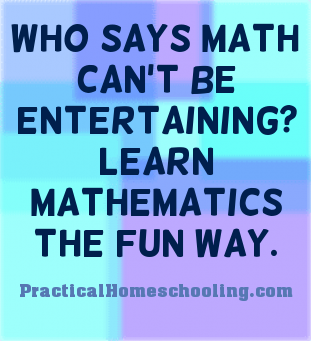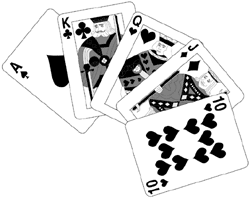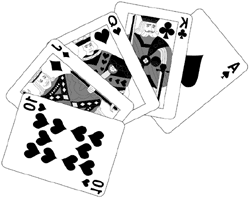 Kids playing games with negative numbers? Fun games that provide basic fact practice? Yes! In this column, I will describe several games that do just that. Each game uses a standard deck of playing cards, with the ace, jack, queen, and king. For those who don't own a regular deck or prefer not to, some school supply stores do carry number card decks showing the numerals 0 through 10, with the size, thickness, and feel of regular playing cards. But whichever kind of cards are used, for our family these kinds of games have fostered togetherness, laughter, enjoyment, and teaming.
Kids playing games with negative numbers? Fun games that provide basic fact practice? Yes! In this column, I will describe several games that do just that. Each game uses a standard deck of playing cards, with the ace, jack, queen, and king. For those who don't own a regular deck or prefer not to, some school supply stores do carry number card decks showing the numerals 0 through 10, with the size, thickness, and feel of regular playing cards. But whichever kind of cards are used, for our family these kinds of games have fostered togetherness, laughter, enjoyment, and teaming.
Playing Zero
An excellent card game is one called "Zero." "Zero" is played with 2 or more players, up to a maximum of about 4. The object of the game is to be the player with the score closest to zero. Black cards have positive values, and red cards are negative (following the traditional accounting terminology in which being "in the black" means having a positive balance, while being "in the red" means a negative balance). The ace = 1, face cards = 10, and all other cards have their own face value. So, a black 7 = +7 points, and a red 9 = -9 points. Each player is dealt one card to begin with and has the option of getting up to 4 extra cards during that hand, for a total of five cards maximum. Let's say that l am the first player to the left of the dealer. My initial card (dealt face up) is a black 5, so my beginning score is +5. That's not very close to zero, so l ask for another card. The next card is a black 9, worth +9 points, so my score is now +5 + +9 = +14. Now I almost have to ask for another card, hoping that it will be a negative (red) card, which will bring my score down. The dealer next deals me a red Jack, worth -10 points, so my score goes down 10 points, from +14 down to +4 (that is, +14 + -10 = +4). Now, I think I can get still closer to zero, so I ask for another card, which turns out to be a red 6. With this red 6, my score goes down 6 points, from +4 down to -2 (that is, +4 + -6 = -2), Although I could get one more card, I decide that my score of -2 is pretty close to zero, so I announce to the other players that I'm done. As I have been playing, the other players have been watching and listening to me figure my score as the cards are laid out - sometimes even correcting my arithmetic! The next player then goes through a routine like mine, stopping whenever that player wants. The hand is won by the player whose score is closest to zero. A wining hand is worth 2 points; a tie is worth 1 point, with play continuing to some agreed upon sum such as 21 or 15.
To beat my score of -2, which is only 2 away from zero, another player would have to get a score of +1, or 0, or -1, all of which are "closer" to zero than is -2. A player could tie my score by also getting a score either of -2 or of +2, both of which are 2 away from zero. In any case, each player is allowed a maximum of 5 cards total and can stop at any time, having as few as one card in hand.
Most children have an experiential sense of negative numbers, often from real world situations such as owing money ("Dad, I owe you 5 pennies, but I have only 3 pennies, so I still owe you 2 pennies") or dealing with cold temperatures ("The current temperature of 4 degrees above zero will drop 7 degrees to 3 degrees below zero"). The game of "Zero" provides informal but intensive work with both positive and negative answers. By the way, the symbol -8 should be verbalized as "negative eight" (not "minus eight") and +5 as "positive five" (not "plus five"). The terms minus and plus should be left to the operations of subtraction and addition, respectively.
 Math War
Math War
The classic card game of "War" can also be used as a math game, simply by incorporating the operations of addition, subtraction, and multiplication. For these variations, remove the Kings and Jacks, but leave the Queens in the deck to act as a zero (the capital Q looks a bit like a 0). Let the ace = 1; all other cards have their own face value. Two players deal out all the cards, and then each turns over one card at the same time. If addition facts are being practiced, then the winner of this hand is the first player to say the proper addition answer for the two cards shown. That player then takes possession of both cards and places them in his own "won" pile. When a player's cards in hand have all been played, that player takes all the cards in his "won" pile, shuffles them, and begins play again.
The object of the game can be set up in a couple ways: either to possess the most cards after a given period of time (say 5 to 10 minutes - set a timer), or to completely acquire all of your opponent's cards. (Beware! This variation can take a long time.)
For the subtraction version, the winner is the first to name the result of the bigger card minus the smaller card. For a 7 and a 9, the winner can simply call out "2" for the answer of "9 - 7." However, for more mature children, negative answers can be be encouraged, with the important condition that the problem must also be stated in the proper order. For a 7 and a 9 again, the winner is the first to call out "7 - 9 = -2" or "9 - 7 = 2." However, both "7 - 9 = 2" and "9 - 7 = -2" would be incorrect, as these last two answers are simply wrong.
"Math War" game can also be played, of course, using multiplication. In each version, however, if an adult is playing against a child, the adult can take a handicap of having to count, say, to 3 silently before stating the answer. When playing this game with my sons when they were younger, my handicap was larger; I would have to count to 5 before saying an answer, to make the game more competitive for them. As they grew older, my handicap went down, sometimes to a count of only "one thousand one" before answering.
Ten-Twenty-Thirty
"Ten-Twenty-Thirty" is another excellent card game. This game was my favorite math solitaire game when I was growing up, and both I and my brother (a university math professor!) still play it every now and then as adults. With a full deck of regular cards, each card is worth its face value, with Ace = 1 and J, Q, K = 10. The object of the game is to have as few cards as possible remaining in your stack after going through the entire deck once only. Shuffle the deck, then lay down cards one at a time face up, horizontally overlapping but so that each card's value can still be seen. Cards can be removed only in groups of three if the three cards add to a sum of 10 or 20 or 30.
Suppose the first three cards you lay down, left to right, are 4, 7, 9. With these cards, 4 + 7 + 9 = 20, so these three cards are removed from the stack and placed in a discard pile.
Now lay out another three cards to begin again. Suppose you lay out 2, 5, 1. Since 2 + 5 + 1 = 8 and is not equal to 10 or 20 or 30, then you lay another card face up on the right end of the stack. If the next card is an 8, then your stack is now (from left to right) 2, 5, 1, 8. Once the stack has more than three cards, you can examine what I'll call
- Group A - the three leftmost cards (2, 5, 1)
- Group B - the two leftmost cards and the one rightmost card (2, 5, 8)
- Group C - the one leftmost card and the two rightmost cards (2, 1, 8)
- Group D - the three rightmost cards (5, 1, 8)
Do any of these sets add to 10 or 20 or 30? Starting from the leftmost group, Group A is 2 + 5 + 1 = 8, so no; Group B is 2 + 5 + 8 = 15, so no; Group C is 2 + 1 + 8 = 11, so no; and Group D is 5 + 1 + 8 = 14, so no again. Lacking a sum of 10 or 20 or 30, you now deal another card on to the right end of your stack.
Suppose you now deal a 9 so that your stack becomes 2, 5, 1, 8, 9. Your possible sums are:
- the leftmost Group A of 2 + 5 + 1 = 8
- Group B of 2 + 5 + 9 = 16
- Group C of 2 + 8 + 9 = 19
- the rightmost Group D of 1 + 8 + 9 = 18
You still don't have any sum of 10 or 20 or 30, so you deal the next card on to the right end of the stack. Before dealing the next card, note that the "middle group" of 5 + 1 + 8 is not an option - you can't take cards out of the middle of the stack. The three cards you take must be taken from either or both ends of the stack.
Suppose your next card is a 3. Now your stack is 2, 5, 1, 8, 9, 3. Do you see the group that adds to 10 or 20 or 30? The underlined group here yields a sum of 2 + 5 + 3 = 10. But wait! There is another group, too: (8, 9, 3), which yields a sum of 8 + 9 + 3 = 20. You can remove either group of three cards (but not both).
Let's say you remove the 8, 9, and 3. The remaining cards in your playing stack are now 2, 5, 1. This process is repeated, all the while looking for sums of 10 or 20 or 30, with the object of the game to have as few cards as possible left in your stack when you run out of cards to deal. The fewest possible cards to have left is one, since a complete deck of 52 cards with repeated removals of three cards will at best leave a remainder of one card. Sometimes, I may have twenty-one or more cards left in my stack - there simply weren't many combinations summing to 10, 20, or 30. I consider it a good game if I have seven or four cards left. Having only one card left in this game is comparable to a game of 300 in bowling - it's simply the best score possible, and it doesn't happen that often.
 Thinking Ahead
Thinking Ahead
After mastering the essentials of the "Ten-Twenty-Thirty" game (perhaps much later for younger children), you can encourage children to begin to think ahead on what values would work for the next card to create a group of three that adds to 10 or 20 or 30. To return to our last stack of 2, 5, 1, if we call the next card N, then our stack is 2, 5, 1, N. For Group B (2, 5, N), what value of N makes "2 + 5 + N" equal 10 or 20 or 30? Only N = 3 will work. For Group C (2, 1, N), what value of N makes "2 + 1 + N" equal to 10 or 20 or 30? Only N = 7 will work. For Group D (5, 1, N), what value of N makes "5 + 1+ N" equal to 10 or 20 or 30? Only N = 4 will work. Thus, by "thinking ahead" you can determine that if the next card is a 3 or a 7 or a 4, then you will be able to remove cards. This is in fact a very preliminary form of algebra; working with unknown numbers, which in this case is the value of the next card ("unknown" before you turn it over), all the while doing a lot of addition and subtraction practice.
What makes games like "Ten-Twenty-Thirty" effective is that there is simply so much number crunching in playing it! Every new card laid down creates three new combinations of these triple sums to check. This repeated addition practice is in some ways more effective than flash cards or drill sheets, because it provides the practice in an enjoyable way (as does any enjoyable game involving repeated addition). Furthermore, in this game situation, the skills of addition and subtraction are the means to an end (a way to win the game!) rather than being ends in themselves.
More Than Just the Facts
So, is basic fact mastery a goal in itself, or is it a means to achieve other goals? Basic fact mastery does have significance and elegance as a goal in itself - it helps reveal the understandable orderliness and extreme consistency of God's created order. But for the most part, basic fact mastery is primarily a means to achieving other goals, such as adding up purchases, keeping inventories, making plans and estimates, and so forth.
If basic fact mastery is for the most part a means to an end, rather than an end in itself, we adults should provide our children with practical experiences in which those skills are used along the way in order to achieve other goals, such as having fun, building things, or winning games. Yes, there should be times when those same skills are practiced in isolation - just not all the time! Achieving basic fact mastery only through flash cards and drill sheets would be like learning to play piano by only playing scales and never getting to practice lighthearted melodies, play beautiful hymns, listen to excellent music, or lead a family singalong at the piano. Mathematical card games can provide the variety and motivation to help engage the three key elements of memorization: repetition, repetition, and repetition. If you are not convinced, try putting this article down, finding a deck of cards, and playing a round of "Ten-Twenty-Thirty." You'll see how much basic fact practice is used in just one game, and it's fun. Take pleasure in this aspect of God's created order, and let your children do so, too.